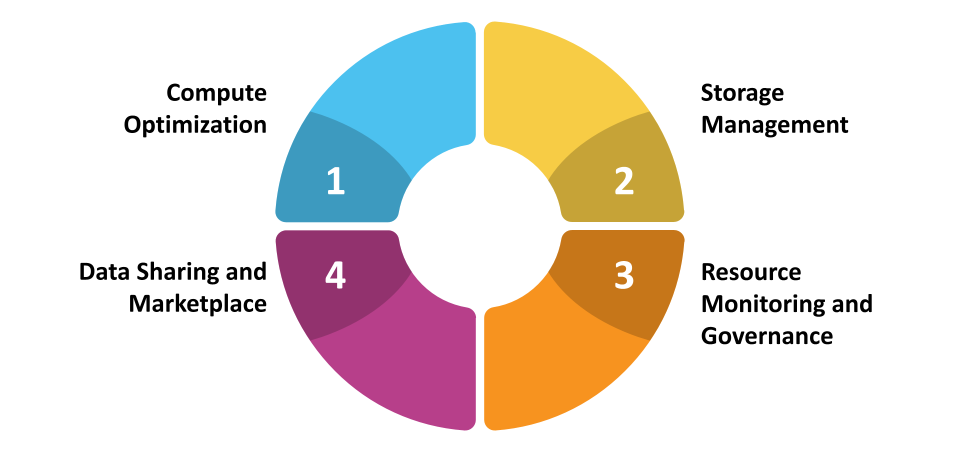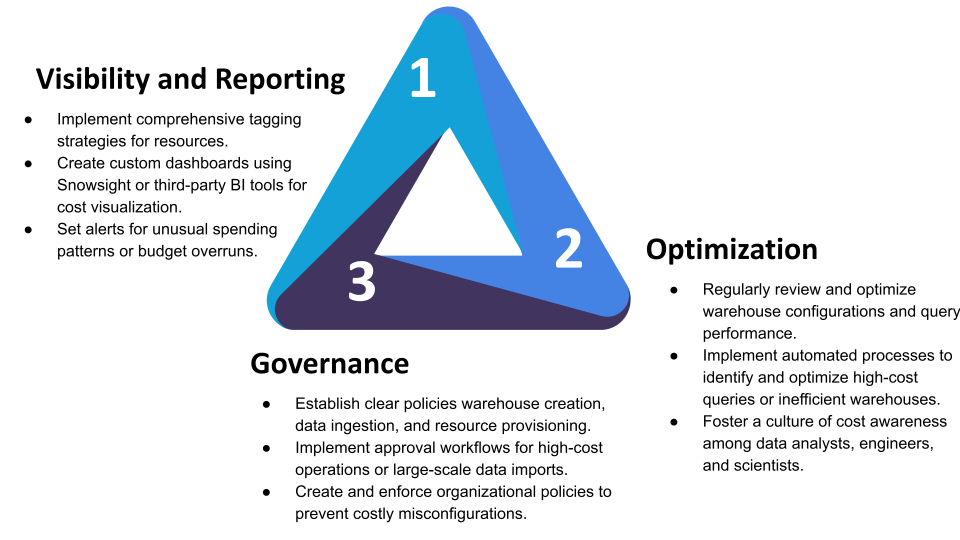Mastering Snowflake Cost Management and FinOps: A Comprehensive Checklist
Effective cost management becomes paramount as organizations leverage Snowflake’s powerful cloud data platform for their analytics and data warehousing needs. This comprehensive checklist explores the intricacies of cost management and FinOps for Snowflake, delving into strategies to inform, govern, and optimize usage while taking a holistic approach that considers queries, storage, compute resources, and more.
While this checklist is comprehensive and very impactful when implemented fully, it can also be overwhelming to implement with limited staffing and resources. AI-driven insights and automation can solve this problem and are also explored at the bottom of this guide.
Understanding Cost Management for Snowflake
Snowflake’s unique architecture separates compute and storage, offering a flexible pay-as-you-go model. While this provides scalability and performance benefits, it also requires careful management to ensure costs align with business value.
Effective Snowflake cost management is about more than reducing expenses—it’s also about optimizing spend, ensuring efficient resource utilization, and aligning costs with business outcomes. This comprehensive approach falls under the umbrella of FinOps (Financial Operations).
The Holistic Approach: Key Areas to Consider

1. Compute Optimization
Are compute resources allocated efficiently?
Virtual Warehouse Sizing: Right-size your virtual warehouses based on workload requirements.
Auto-suspend and Auto-resume: Leverage Snowflake’s auto-suspend and auto-resume features to minimize idle time.
Query Optimization: Write efficient SQL queries to reduce compute time and costs.
Materialized Views: Use materialized views for frequently accessed or complex query results.
Result Caching: Utilize Snowflake’s result caching to avoid redundant computations.
2. Resource Monitoring and Governance
Are the right policies and governance in place? Proper monitoring and governance are essential for cost management:
Resource Monitors: Set up resource monitors to track and limit credit usage.
Account Usage and Information Schema Views: Utilize these views to gain insights into usage patterns and costs.
Role-Based Access Control (RBAC): Implement RBAC to ensure appropriate resource access and usage.
3. Storage Management
Is storage managed efficiently? While storage is typically a smaller portion of Snowflake costs, it’s still important to manage efficiently:
Data Lifecycle Management: Implement policies for data retention and archiving.
Time Travel and Fail-safe: Optimize usage of Time Travel and Fail-safe features based on your data recovery needs.
Zero-copy Cloning: Leverage zero-copy cloning for testing and development to avoid duplicating storage costs.
Data Compression: Use appropriate compression methods to reduce storage requirements.
4. Data Sharing and Marketplace
Are data sharing and marketplace usage optimized?
Secure Data Sharing: Leverage Snowflake’s secure data sharing to reduce data movement and associated costs.
Marketplace Considerations: Carefully evaluate the costs and benefits of data sets or applications from Snowflake Marketplace.
Implementing FinOps Practices
To master Snowflake cost management, consider these FinOps practices:

1. Visibility and Reporting
Implement comprehensive tagging strategies for resources.
Create custom dashboards using Snowsight or third-party BI tools for cost visualization.
Set up alerts for unusual spending patterns or budget overruns.
2. Optimization
Regularly review and optimize warehouse configurations and query performance.
Implement automated processes to identify and optimize high-cost queries or inefficient warehouses.
Foster a culture of cost awareness among data analysts, engineers, and scientists.
3. Governance
Establish clear policies for warehouse creation, data ingestion, and resource provisioning.
Implement approval workflows for high-cost operations or large-scale data imports.
Create and enforce organizational policies to prevent costly misconfigurations.
Setting Up Guardrails
Implementing guardrails is crucial to prevent unexpected costs:
Resource Monitors: Set up resource monitors with actions (suspend or notify) when thresholds are reached.
Warehouse Size Limits: Establish policies on maximum warehouse sizes for different user groups.
Query Timeouts: Configure appropriate query timeouts to prevent runaway queries.
Data Retention Policies: Implement automated data retention and archiving policies.
The Need for Automated Observability and FinOps Solutions
Given the complexity of modern data operations, automated solutions can significantly enhance cost management efforts. Automated observability and FinOps solutions can provide the following:
Real-time cost visibility across your entire Snowflake environment.
Automated recommendations for query optimization and warehouse right-sizing.
Anomaly detection to quickly identify unusual spending patterns.
Predictive analytics to forecast future costs and resource needs.
These solutions can offer insights that would be difficult or impossible to obtain manually, helping you make data-driven decisions about your Snowflake usage and costs.
Snowflake-Specific Cost Optimization Techniques
Cluster Keys: Properly define cluster keys to improve data clustering and query performance.
Search Optimization: Use search optimization service for tables with frequent point lookup queries.
Multi-cluster Warehouses: Leverage multi-cluster warehouses for concurrency without over-provisioning.
Resource Classes: Utilize resource classes to manage priorities and costs for different workloads.
Snowpipe: Consider Snowpipe for continuous, cost-effective data ingestion.
Conclusion
Effective Snowflake cost management and FinOps require a holistic approach considering all aspects of your data operations. By optimizing compute resources, managing storage efficiently, implementing robust governance, and leveraging Snowflake-specific features, you can ensure that your Snowflake investment delivers maximum value to your organization.
Remember, the goal isn’t just to reduce costs, but to optimize spend and align it with business objectives. With the right strategies and tools in place, you can transform cost management from a challenge into a competitive advantage, enabling your organization to make the most of Snowflake’s powerful capabilities while maintaining control over expenses.
By continuously monitoring, optimizing, and governing your Snowflake usage, you can achieve a balance between performance, flexibility, and cost-efficiency, ultimately driving better business outcomes through data-driven decision-making.
To learn more about how Unravel can help optimize your Snowflake cost, request a health check report, view a self-guided product tour, or request a personalized demo.


